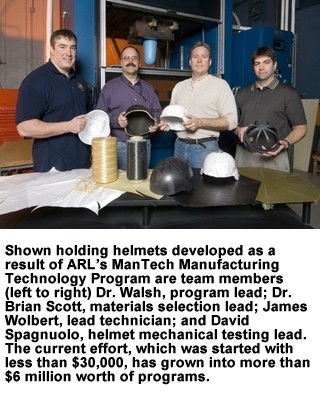
ABERDEEN PROVING GROUND, Md. - A team of investigators from the Army Research Laboratory has recently developed a new process for making helmets that will provide up to 20-25 percent more ballistic protection than previous models. The process fabricates ultra-high molecular weight polyethylene fibers, or UHMWPE, and other materials into near-net formed, highly compressed helmets.
Developed as part of the ManTech Program, which supports the needs of the Army's acquisition community during the production and fielding of weapon systems and materiel, the new helmets represent a significant advance over those currently used by the Army, which use aramid and other fibers. Aramid fibers have been used in U.S. helmets since the late 1970s.
The ManTech Program is investigating the barriers associated with fibers such as UHMWPE, which have even higher levels of ballistic mass efficiency, but due to processing complexities and cost, have not been adopted into Army helmets.
According to Dr. Shawn Walsh, who leads ARL's team of investigators, "successful implementation of these next generation thermoplastic-based technologies will provide the Warfighter with the next level of superior protection, but not before rigorous and careful testing prove the advantages of both the process and properties of the new helmets."
Key to this testing and process development lies in the participation of three of the United States' largest ballistic helmet manufacturers: BAE Systems (formerly Armor Holdings/Simula), MSA, and GENTEX Corporation. Diaphorm LLC, Fiberforge, and Intermaterials LLC are smaller companies also participating in the program. "Successful prototyping and processing in an Army lab is not enough. Contractors must prove the new technologies on an actual shop floor," said Walsh.
The UHMWPE helmets pose unique challenges. For example, they are more compliant than traditional ballistic aramid/phenolic materials and must be combined with secondary materials to retain the desired structural integrity.
Dr. James Zheng, chief scientist for PEO Soldier, witnessed a recent successful "crush" test of a UHMWPE helmet concept developed by ARL. The crush test has historically proven difficult for monolithic UHMWPE systems.
Groundwork Laid in Massachusetts
ARL has historically been involved in helmet development. Years ago, at the Army Materials and Mechanics Research Center, AMMRC, in Watertown, Mass., researchers worked with a DuPont product called "Fiber B," which now is more commonly known to consumers as "Kevlar."
Fiber B was found to have extraordinary tenacity and ballistic resistance. AMMRC and Natick molded the first helmets using this new material. Eventually, it became known as the Army's Personnel Armor System for Ground Troops, sometimes abbreviated to PASGT, and represented a revolution in which steel was replaced by an organic, man-made fiber that provided nearly 30 percent more ballistic protection.
While incremental improvements in Kevlar fiber have been made since PASGT, resulting in better helmets, UHMWPE materials offer significantly higher levels of mass-efficient performance.
The current ARL helmet materials and fabrication effort, which was started with less than $30,000, has since grown into more than $6 million worth of programs.
This includes the three-year ManTech Program ARL is leading, pioneering new and practical manufacturing methods to fabricate thermoplastic-based helmets capable of achieving 20 to 25 percent more protection than current helmets using UHMWPE materials as SpectraTM and DyneemaTM and DuPont's thermoplastic aramid, Mark III.
Other Internal and External Organizations Lend Their Support
Materials researchers have worked with other scientists and engineers in ARL on helmet design and sound localization, developing and integrating physiological and acoustic sensor arrays, and in the testing and visualization of ballistic impact of helmets.
ARL has also been involved with MIT, University of Alabama at Birmingham, Florida A& M University, Tufts University, Florida State University, and South Dakota School of Mines and Technology on related helmet and composite materials research.
Finally, ARL has cultivated a critical partnership with both Natick Soldier Research, Development and Engineering Center and PEO Soldier in a collaborative effort to systematically identify opportunities for these new processes and materials, as well as reduce the risk associated with implementing these technologies during their manufacture.
The Army's goal is to develop manufacturing technologies that will lead to the next generation of superior Soldier protection. ARL, as it has been in the past, will be at the forefront in ensuring that the goal is reached.

Social Sharing